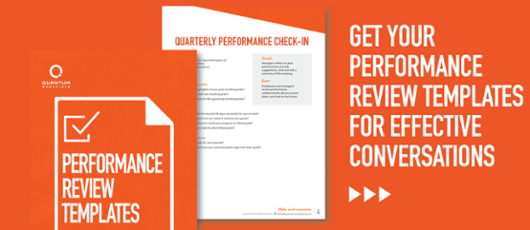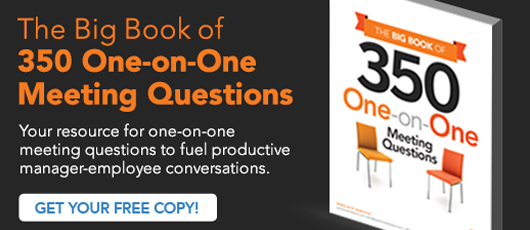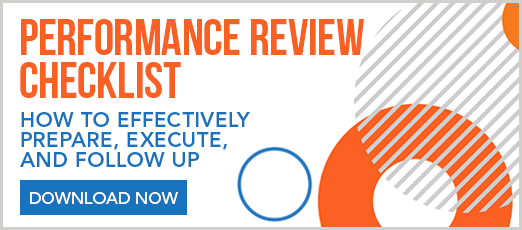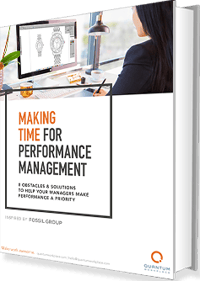Good Points to Bring Up During a Work Review
The employee operation review has received a lot of criticism in contempo years. Traditional employee appraisal processes have been causing headaches for both managers and employees. And nearly employees believe functioning reviews are not effective at driving performance. There's still a place for the annual operation review. But success-driven organizations know it must be part of a bigger performance chat strategy. Regardless of whether you're conducting an almanac review, a quarterly review, or a monthly functioning bank check-in, performance conversations can be difficult. Managers should endeavor to create positive experiences that motivate employees and bulldoze high performance. But creating that kind of experience is easier said than done. Earlier we dive into the tactical side of functioning reviews, it'due south important to sympathize what a performance review is and why it is important. This will give you the foundation you need to start using performance reviews more than effectively in your organization. Traditionally, performance reviews accept occurred once a yr and accept focused on evaluating by operation. Modern functioning reviews should happen quarterly or monthly and should focus on driving and improving future operation. Functioning reviews give employees and managers a adventure to discuss how employees are doing and how they can do better, together. Done right, they tin appoint and motivate employees to maximize and marshal their efforts. Done wrong, they can ship employees downwardly a disengagement screw—and even decrease performance. How do y'all choose the right performance appraisal method? Below are a few important elements to consider. If yous desire to cultivate employee success, y'all must branch beyond the traditional, annual review. And so much can change in your system or with your employees in 1 year. It's of import to stay aligned and to keep communication going during those changes. We recommend quarterly or monthly performance conversations, paired with a year-end review of general themes, notes, progress, and side by side steps. This allows managers and employees to stay on the aforementioned page near goals, progress, and functioning. Information technology besides helps: Many organizations are turned off by a quarterly or monthly performance review cadency because it feels like a hefty time commitment. Only if you're having frequent conversations, they don't need to be long, robust, or comprehensive to be constructive. Not only should performance conversations happen more frequently—they should also be more than engaging. Managers and employees should as contribute to the conversation, and employees should exist just equally invested in the training every bit managers. While at that place isn't a 1-size-fits-all solution for all performance discussions, every conversation should promote trust, reduce feet, create clarity, and showcase alignment. And these conversations don't have to be just about operation. They can address: Traditionally, performance reviews have centered around the past—how the year went, what went well, and what didn't go well. Employees tin can't change the past, so it's pretty disengaging to be evaluated on situations they accept no power to shape. But employees do have the ability to change what happens in the time to come—and this is where the bulk of your functioning conversations should focus. It's good to reflect on the past, just managers and employees should also spend fourth dimension looking forward. Functioning reviews can be anxiety-inducing—and one of the all-time ways to reduce feet is to bring employees into the procedure early and involve them in the preparation and planning. Managers should piece of work with each employee to create a articulate, shared, and collaborative agenda with main points of discussion. Both parties should know exactly what to expect—at that place shouldn't exist whatever surprises! Today we have admission to mountains of information. There's no alibi for subjective performance reviews anymore. Managers should come prepared with data from a variety of sources such as recent recognition, 360 degree feedback, talent review ratings, one-on-i notes, goal progress, and more. Every statement made should be fueled by information—non by the manager'due south personal stance. To recap, here are some key differences between traditional performance reviews and mod performance reviews. Dorsum to top >>> The performance review has taken a lot of flak over the past several years. Many take touted the thought that performance appraisals don't work. But the reality is, operation conversations are a crucial part of the engagement and retentiveness of employees. Why are performance conversations important? Because they have a big impact on the success of your employees, teams, and organization as a whole. Discussing performance can be very stressful. It's tough for managers to give feedback and even harder for employees to receive it. How organizations handle these conversations plays a huge function in an employee's engagement and overall experience. Performance conversations are perfect opportunities to make or pause trust. An open up, honest, and regular dialogue helps to build trust among employees, managers, and the organization at big. Employees want to know—and deserve to know—exactly where they stand in terms of performance. Ongoing functioning conversations can boost employee success by: Performance conversations help managers evaluate team performance past giving them a clear picture of how each squad member is performing. They'll know where the squad is strong, where the team needs help or evolution, how to adjust goals, and the team's potential to touch on larger goals. If employees aren't aligned and on a articulate path to their ain success, organizations volition have difficulty achieving important goals and objectives. Performance conversations allow managers to connect employees to the bigger mission and goals of the arrangement. They also give organizations the data they demand to make important people decisions related to: compensation, promotions, development, role changes, exits, and more. Dorsum to summit >>> Managers should arroyo whatsoever performance conversation with thoughtful preparation and lots of information and examples. In this department, nosotros'll talk over how to prepare for a performance review past: Managers and employees should accept a articulate understanding of what constitutes good or poor performance—and this starts with organizations clearly communicating operation criteria. Effective operation criteria should help managers and employees: Performance criteria and ratings can be hard to address and digest. Managers should human activity as interpreters of that data by adding qualitative context (such as goal progress or 360 feedback) to performance. They should arroyo performance reviews with a coaching mindset, highlighting and distilling data to get in easier for their employees to consume. Managers can too provide emotional support past not letting employees dwell on the negative—and instead focusing on what employees are doing well and uncovering opportunities to form correct. Each functioning conversation is an opportunity to build trust past helping employees empathize where they are, allowing them to share, and providing guidance on where they need to go. Back to height >>> Increasing the frequency of performance conversations in your organization might take some convincing—but the more than oftentimes that you run into, the more effective your conversations and performance will be. Finding time is difficult. And getting in the right mental and emotional state can be even harder. Simply making functioning reviews a priority means that employees will feel heard, managers will passenger vehicle more than effectively, and the organization will reap the results. The surround you choose for your performance conversations has a big impact on the overall vibe of the discussion. With your workspace in mind, think well-nigh what bulletin yous will be sending based on the location, time, noise, and comfort level of your meeting space. Here are a few elements to consider when making fourth dimension and space for your performance review: These elements are important, simply ensuring managers classify plenty of time and capacity for these conversations is some other claiming. Take a page out of Fossil Grouping's book, and see how they found the time and infinite to impact functioning at every level of the arrangement. With and then many shifting priorities and aggressive strategic objectives, Fossil Group knew they needed to exercise something special to brand functioning a priority for their teams. To ensure adequate fourth dimension was made for important performance conversations and other performance related activities, Fossil Group implemented "Operation Days." Performance Days are strictly defended to employee performance. No task-related meetings are scheduled, and all work is set aside for the day. Conversations between managers, employees, and teams are all centered on operation. Back to pinnacle >>> Performance conversations used to exist based on subjective manager opinions. But in today'south information-driven world, that shouldn't be the case. Managers should approach performance conversations with rich employee data from a multifariousness of sources. This data should assistance guide the conversation and build a more meaningful relationship between manager and employee. Bring data and examples from: All of these are dandy ways to shed light on a diverseness of dissimilar aspects of an employee'southward performance. The more data you lot can provide to add together context to any difficult or even positive discussions, the more existent your conversations will be. Past leveraging functioning criteria, an employee's opinion of perceived fairness of performance review results will be all the more than authentic instead of leaving a bitter gustatory modality in their mouth. Dorsum to top >>> No i enjoys walking into a meeting blindly. Operation conversations are no exception. In order to give managers and employees the all-time opportunity to take a meaningful chat most operation, both parties should work together to prepare a shared calendar and notes with key talking points. This will salve some of the feet around the conversation and will requite employees a take chances to contribute their thoughts and prepare for the coming together. It also allows employees to conform the calendar to fit their needs. When employees are encouraged to bring topics they want to hash out, managers can focus on actively listening rather than lecturing. Your meeting agenda should as well include the time and location in which you lot are meeting, likewise as any ancillary information to support the conversation. Back to top >>> Performance conversations are sometimes difficult. When employees aren't achieving goals or objectives, these meetings can help determine why and how to help an employee meliorate. Start off on the correct human foot past adjustment on expectations for the coming together itself. Here are a few tips: Above all, managers and employees should have a shared understanding of what expert performance looks like. When necessary, managers should provide clarity around each employee's office and how the arrangement perceives their contributions. By aligning expectations with your organization'due south established performance criteria, your employees won't feel misguided or alarmed when their review begins. Back to top >>> The 3rd step to executing an effective operation conversation is conducting the performance review coming together itself. This section will overview: Traditional performance reviews focus on past behavior and operation. While acknowledging past performance is important, if that's the only matter y'all talk near in a performance review, you're not going to drive future performance. Performance conversations should requite employees an opportunity to accost and correct performance in real-time and continuously see how their piece of work aligns with organizational goals. Future-focused operation reviews also align with employee wishes for more feedback and development opportunities. Employees want firsthand feedback so they can improve performance on-the-go, rather than waiting for their annual performance review. They too want to know you intendance about their future—whether that's with your organization or not. Back to acme >>> Asking (and inviting) the right performance review questions is disquisitional. The right questions assistance continue you focused on the topics that are important to your employees' and system's success. Pro Tip: Use a operation review template that invites honest, 18-carat feedback and uncovers actionable ways to improve performance. Hither are a few good questions to ask in a performance review: Managers who approach performance conversations with an evaluation mindset may make employees feel like they're on trial. Ask these questions to shift your mindset from judge to double-decker. And e'er encourage employees to inquire questions of yous. Past coaching your employees and inviting them to contribute to the conversation, you can piece of work together to help them attain their goals. Back to summit >>> Your words carry a lot of power. They can be motivating to your employees or completely deflate their piece of work and value. When meeting with your employees yous'll want to be thoughtful, considerate, and take the fourth dimension to ready. While in that location are many ways you lot could arroyo a functioning conversation, what not to say in a performance review is just, if not as, as of import as what to say. Here are a few tips for choosing constructive functioning review phrases: Back to height >>> Performance conversations should be two-fashion, so make sure yous're facilitating a dialogue and actually listening. Listening to your employees helps y'all learn and sympathise rather than simply requite someone equal talking time. Ask follow-up questions to help yous dig deeper and paint a fuller picture. Using emotional intelligence, you can tap into your and others' emotions. Seek to understand how the other person may be feeling, and work to keep your emotions in check if needed. Finally, participating in the conversation isn't always about sharing your indicate of view. Subsequently an employee shares their feedback, repeat dorsum what you heard. This gives you lot the opportunity to check that you accurately understood what the other person said. If you're spending your listening time preparing your response, then yous're not actually listening to the other person. Back to top >>> A performance conversation shouldn't end when the meeting is over. After the chat concludes managers and employees should review notes, define next steps, and follow upwardly with shared comments and feedback. Without these items, functioning conversations experience unresolved. If you lot want your review to really better performance, creating an activeness plan is vital. Back to top >>> The final footstep to executing an effective review is the employee performance follow-upwards. After the meeting ends, employees will need continued support to attain the goals you've created together. Keeping the conversation going and maintaining an open-door policy will ensure your employees feel supported and set up up for success. Performance conversations should happen regularly. When your meeting concludes, put the next performance conversation on the calendar. Better nevertheless, schedule a series of conversations throughout the year. Whether these meetings occur quarterly or monthly, setting a regular cadency shows you are invested in your employees' connected growth and development. Even if your organisation hasn't fabricated the switch to more regular conversations, information technology can exist helpful for managers to plant an admissible policy with employees and then that they experience comfortable discussing their operation all twelvemonth long. Pairing this policy with 1-on-ane meetings and pulse checks throughout an employee'due south lifecycle is a skillful fashion to move toward a continuous performance conversation model. Back to top >>> Searching for a manner to motivate and align your teams' performance? Notice a tool to help exercise the heavy lifting. Look for performance review software that features: Effective functioning conversations are an essential part of your operation management strategy. Your functioning management software should aid you get there. Navigate your next employee performance review without breaking a sweat! Our Performance Review Checklist volition help you effectively prepare for, facilitate, and follow-up on your performance conversations. 
Understanding performance reviews
What is a Performance Review?
A performance review is a two-manner, individualized conversation between a managing director and an employee about performance affect, development, and growth. It is a disquisitional component of an organization'south overall operation management strategy.1. Know the elements of an constructive operation review.
Functioning reviews should happen frequently.
Performance reviews should be two-way conversations.

Performance reviews should be future-focused.
Performance reviews should exist transparent.
Operation reviews should be objective.
Traditional Performance Review
Mod Performance Review
2. Understand why the operation review is important.
How Performance Reviews Touch Employee Success
How Functioning Reviews Touch on Team Success
How Operation Reviews Impact Organizational Success
How to prepare for a functioning review

3. Sync performance criteria, employee goals, and progress.
iv. Make time and infinite for performance reviews.
Location
Time
Dissonance
Visual/Condolement
How Fossil Group Fabricated Fourth dimension for Performance Management with "Performance Days"


5. Assemble employee information and examples.
vi. Fix notes and calendar.
7. Align on expectations for your employees.
How to deport a performance review
8. Reverberate on the past simply focus on the hereafter.
ix. Inquire the right operation review questions.

x. Choose your phrases carefully.
11. Be an active listener.
12. Wrap up the conversation with agreed upon side by side steps.
How to follow up after a performance review
xiii. Keep the conversation going.
Bonus Tip! Find the correct functioning review software to brand reviews easier.

Source: https://www.quantumworkplace.com/future-of-work/13-performance-review-tips-that-actually-improve-employee-performance
0 Response to "Good Points to Bring Up During a Work Review"
Post a Comment